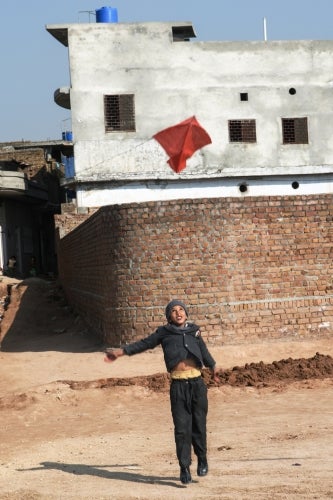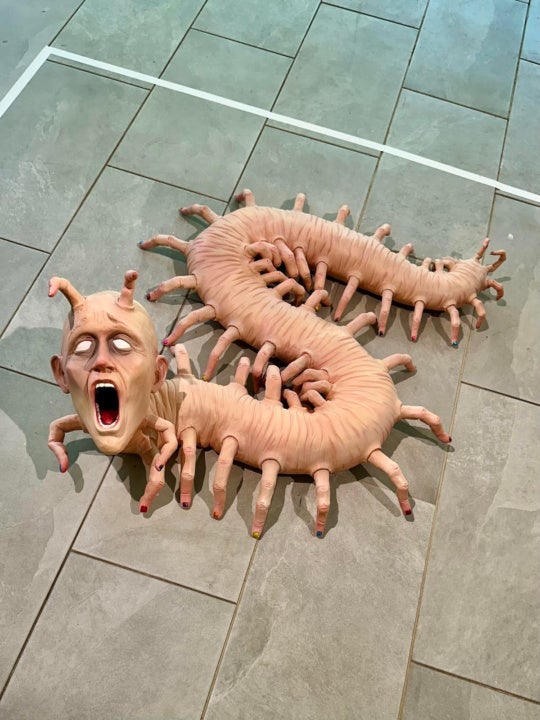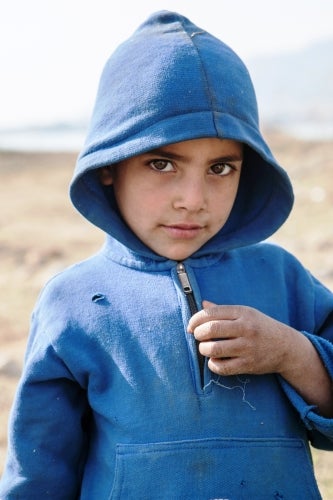
John E. Ramspott’s “Not My Enemy: Photographs from Pakistan, Cambodia, and East Ukraine,” at Stan McCollum Gallery through November 22, illustrates a possible way of looking at information regarding often-stereotyped cultures. It also illustrates, more than most shows, how profoundly an exhibition is shaped by choices regarding the quantity and the format of the prints exhibited.
Ramspott traveled via Kiev to Donetsk in the early weeks of the self-proclaimed Donetsk People’s Republic, and brought back memorable photographs of an anomalous city in which normal civilian life continued within a few blocks of the occupied government buildings. His personal emails and Flickr account presented views of a palatial-looking McDonald’s, a wall mural of John and Yoko holding a “War Is Over” placard that was a major feature of his room at a music-themed Donetsk hotel, and a sweet-tempered image of friends sitting at outdoor café tables disconcertingly close to the center of an armed uprising.
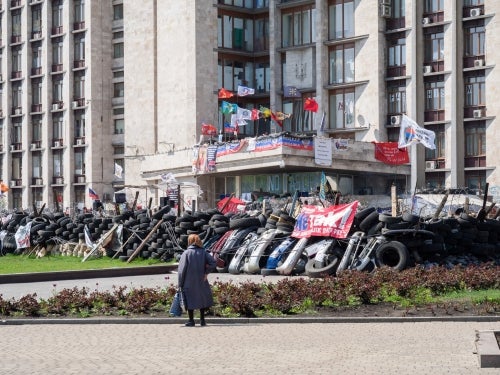
Ramspott chose only four photographs from this body of work for “Not My Enemy”: a simultaneously arresting and amusing image of a Woman Looking at Pro-Russian Separatist Headquarters (the babushka-wearing, bag-laden woman’s posture suggests curiosity or bewilderment), a dramatic action photo of a Russian Separatist in Hood, a vaguely ominous line of men posing for Ramspott’s camera Behind the Barricades, and a child standing alone amid a civilian crowd in the interior courtyard of the occupied Parliament, Girl Living in Separatist Headquarters.
That last image is one of the keys to this exhibition. Although part of Ramspott’s point is that even the armed separatist in a ski mask wasn’t inclined to harm him personally, the charmingly posed child living with her mother in the heart of potential danger rhymes visually with the even more sweetly posed Little Girl at Funeral photographed in Cambodia and the innocent Girl on Farm and Kite Flyer in Pakistan.
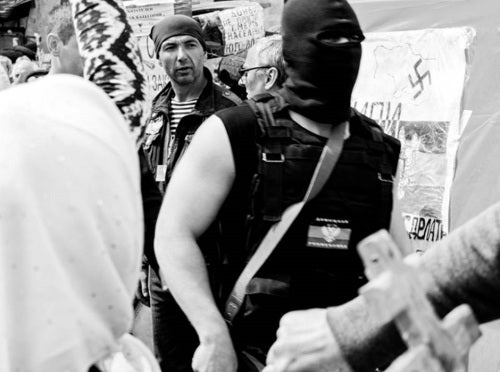
We are in Great Family of Man territory, and indeed Ramspott’s artist’s statement spells out his intent to show that “It is our duty to look beyond the media hyperbole, and look at the human beings”—who are for the most part “people living their ordinary lives. Life goes on despite past or present political upheavals.”
A colorful Horse Drawn Trailer from Pakistan reaffirms this goal, as does a touching photograph of a Female Monk in Cambodia, a series that also features a Man With Child in Floating Village. Only a horrifically injured Land Mine Victim reveals the aftermath of the country’s immense past traumas amid what looks like rural contentment.
If nothing else, these photographs affirm that given even a few moments of civil peace, cultures will carry on their diverse customs in surprisingly resilient ways. The ways, for all their diversity, are not infinite. However, it is not worth rehearsing here the misguided quarrels of academics over whether nature or culture plays the greater role in shaping human societies and individual lives, because they have nothing to do with this show.

Although he is plainly not shying away from the reality of conflict, Ramspott is deeply impressed with the fact that he could travel unmolested in three past or present trouble spots, never encountering antipathy towards himself as an American photographer. He insists, as do some Pakistanis recently writing op-ed pieces, that the headline shorthand of “Pakistan: The Most Dangerous Country in the World” does not do justice to a place that is complex and as multilayered as any other. (He traveled to Pakistan immediately after the assassination of Benazir Bhutto, so he cannot be accused of cherry-picking quiet moments in national history for his documentation of local ways of living.)
“Not My Enemy” contains 13 photographs—four each from Pakistan and East Ukraine, five from Cambodia—all printed on aluminum, giving the colors a peculiarly intense sheen. (The image of the masked separatist is in black and white, which is less affected.) The photographs have an immediate emotional appeal that has helped them find an appreciative audience.
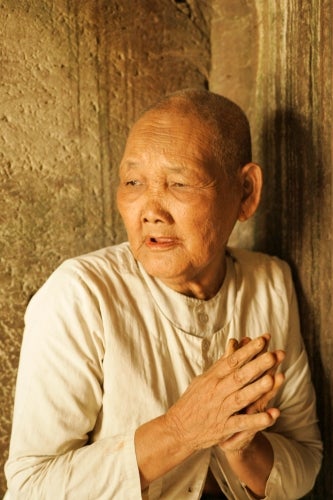
Whether this particular selection serves Ramspott best in terms of his overall career is open to discussion … but the simple financial and physical aspects of creating an exhibition make it challenging to present a larger body of work, even in smaller formats. Nevertheless, the historical and aesthetic force of so many of the photographs that can be viewed on Ramspott’s Facebook page and Flickr account makes me wish that a more comprehensive show of those had been possible.
An entirely different review could be written based on what these 13 photographs say and do not say about the tangled history of the three countries they represent, but I am not going to write it. Much as I wish Ramspott had presented something more extensive, I am fascinated by the several implications of his capacity to locate not just islands of placidity but whole continents of it. Each of these photographs implies an unspoken narrative, and I suspect it is neither quite the one that Ramspott’s sunny nature imposes on it nor the contrary narrative so often implied by the unrelievedly grim images produced by other photojournalists.
Dr. Jerry Cullum is a freelance curator and critic living in Atlanta. His poems, reviews, and essays have appeared in a wide variety of local and national publications, including Art Papers and Art in America.
